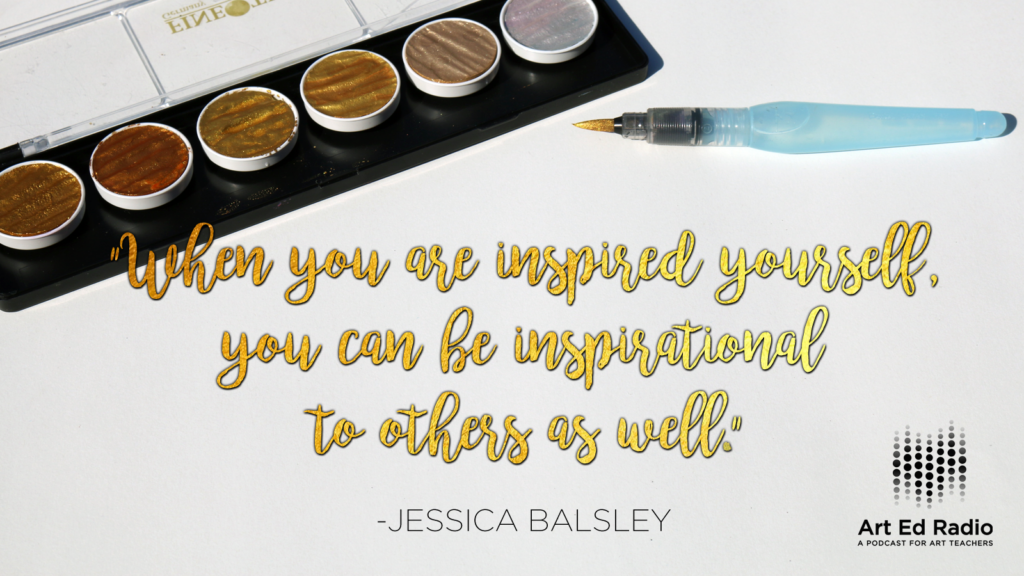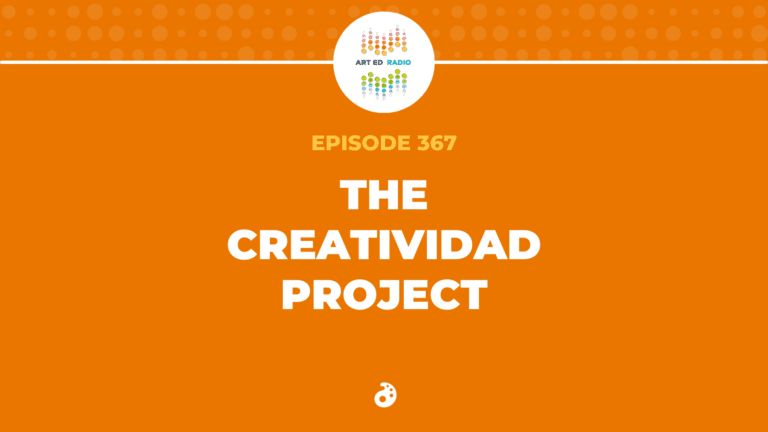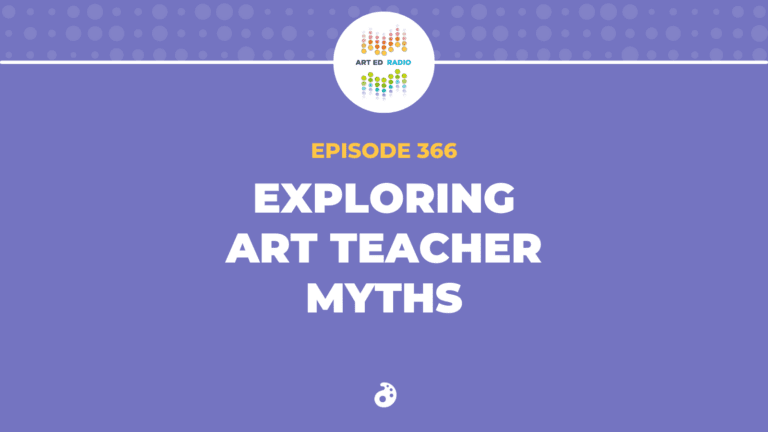AOE Founder Jessica Balsley joins Tim to talk about last week’s interview with Sir Ken Robinson. They share some stories about what it was like behind the scenes of the interview and what it was like working with Sir Ken. They also discuss the importance of art teachers (8:45), how Sir Ken’s books helped influence Jessica to start the Art of Ed (11:15), and how teachers can stay passionate and stay loving what they do (14:15). Full episode transcript below.
If you would like to hear even more from Sir Ken Robinson, he will present “The Importance of Art Teachers” on August 3rd at the 2017 Art Ed Now Summer Online Conference. Details can be found at artednow.com.
Resources and Links:
- Listen to the full Sir Ken Robinson interview
- See more about Art Ed Now, where Sir Ken will be presenting on August 3rd
- Jessica mentioned reading “The Element” a long time ago; here is an old article she wrote that dives in deeper with those ideas
- If you are looking for a chance to rekindle your own passion and creativity, make sure you check out the Creativity in Crisis grad course

Transcript
Welcome to Art Ed Radio, the podcast for art teachers. This show is produced by the Art of Education, and I’m your host, Tim Bogatz. Last week, as I’m sure you heard, Sir Ken Robinson was gracious enough to give me almost of an hour of his time. We had a really wide-ranging conversation about a variety of topics from his own education, to his career, the importance of creativity, the importance of art teachers, and how we can affect school change. It was far and away one of the most popular podcasts we’ve ever done, and if you haven’t listened to it make sure you go back and do that soon. The episode can be found on ArtEdRadio.com.
I’ve received a lot of questions in the last week about the interview. Some on the topics that we covered, but also about Sir Ken himself. What was like it to meet him? How was he in real life? Did he talk to you in person outside of the interview? To be honest, he was about as cool as could be. He was funny, he was charming, and he was so, so intelligent. He had great stories and he was able to just kind of weave them all together in some amazing ways. As I said, that made for some great conversation. I wanted to extend that conversation just a little bit. Today I want to bring on Jessica Balsley, the founder of AOE to talk about a lot of these same topics.
Now, Jessica was also in Los Angeles with me for the Sir Ken interview, and she was able to speak with him as part of his presentation at the Art Ed Now Conference that’s coming up on August 3rd. Now, at the conference he’s going to be talking specifically about the importance of art teachers, which is something you will not want to miss. You can check out all the details at ArtEdNow.com, and see all of the other amazing presentations that’ll be happening.
Talking about Jessica. Like I said, she was in LA for the interview also. She and I are going to chat just a little bit about our trip. Maybe talk a little bit about what it was like behind the scenes of the Sir Ken interview and give you a rundown of what happened, and hopefully answer some of those questions that I’ve been getting so frequently in the last few days. We’re also going to dive in a little bit deeper about Sir Ken’s ideas.
I’m not sure how much of this Jessica really wants me to share, but Sir Ken was a huge inspiration for her when it came to starting the Art of Ed. Just in terms of finding your passion, and following your passion, and working in your element. That was a big reason that she wanted to kind of share her ideas with other art teachers out there, and it’s grown into this amazing thing, but I think it’s cool to talk at least a little bit about kind of where it all started.
Along with all of those ideas, I know she loves to talk about the concept of flow and why we need to find that as art teachers. My guess is we’ll have that be part of the conversation as well. Jessica does a great job of explaining all these ideas, how they apply to art teachers, and how we can get them to apply to our students as well. I know this is going to be a lot to talk about, but I think it will be a really interesting conversation, so let me bring on Jessica and we will get things started. I’m here with Jessica Balsley, the founder of AOE. Jessica, how are you?
Jessica: Hey, Tim. I’m doing great. Thanks for having me. I’m finally happy to be a guest on Art Ed Radio.
Tim: I wanted to kind of talk to you about the Sir Ken Robinson interview because it was such a hit last week and we’ve had so many questions about it. You were there with me with his Art Ed Now presentation recording some of that, but I kind of wanted to let people in a little bit behind the scenes. If we can, let’s talk a little bit about meeting Sir Ken and just what he was like when we were there. He came in with his Starbucks. He needs his coffee just like everybody else, but he was just the most down to earth, nicest guy. Very charming. You got to meet him first, so can you just tell me kind of, what was your first impression of him and what was he like when you were talking to him?
Jessica: Yeah, absolutely. I have to say this was a pinch me moment I think for any art teacher or anyone who knows his work, and so I was, of course, pacing and sweating. Just really, really thrilled to meet him. My first impression was just almost like I was standing at his TED Talk. He has that much poise just in a casual conversation. He sounded and looked just like I had met him a million times online from watching videos and reading his books. For that, that moment was pretty cool just to see him, and talk to him, and say hello, and know that people are as they seem online most of the time.
Tim: I got that impression too. He was very genuine. He had this self-deprecating sense of humor, which I always think is fantastic. He was just a lot of fun to talk to. Let me ask you this, though. I’m curious to know what you thought about his storytelling because for my podcast interview I had this list of questions, it was like 30 questions long that I wanted to ask him. I think I ended up asking two of them because he was telling all of these crazy stories that were just amazing. Then the conversation went all sorts of different directions, which I thought was absolutely fascinating, but were you kind of enthralled by his storytelling as well?
Jessica: Oh, absolutely. I will have to say I have never ever interviewed someone, and you and I have both interviewed a lot of people in our day, who was so poised and had such thought out answers. He was able to recall books, and people he’d met, and dates, and just all of these things that were not pre-scripted. It wasn’t that we had given him every single question. He had no piece of paper to read. It was just his mind is just full of this amazing knowledge and making all these connections.
Yeah, I had maybe 10 to 15 questions planned and I asked maybe three or four just like you, but it was you were sitting in your own mini TED Talk just during the interview. I’ve never had a more pleasing interview process based upon the content and just the poise and expertise. It was really amazing. We all knew it within five minutes of him starting to talk and within five minutes of going. We were all just so excited for this message that he was bringing and we couldn’t wait to share it at Art Ed Now because we just knew it would really be exciting for art teachers to hear.
Tim: I think that’s a perfect transition because that’s what I wanted to ask you about next. I know you interviewed him for his presentation for Art Ed Now. He’s going to be talking about a lot of those connections. He’ll be doing some of that wonderful storytelling, but can you let everybody in on, I guess, kind of a sneak peek about what he’s going to talk about during the conference and kind of it’s specifically geared toward art teachers?
Jessica: Sure. Absolutely. This was kind of the first time that Sir Ken has really spoken specifically to art teachers. Art teachers grasp his message, but really his roots are in music, and theater, and art education. He came over to the United States to, I believe, be a director at the Getty. Education Director.
Tim: Yeah, yeah. He talked about that on the podcast.
Jessica: That particular piece rooted in that art education and he actually helped them with DBAE, which was a big thing at that time. I personally taught a lot of DBAE, so I really grasped onto that. Just his background in working with art teachers and understanding art education is so much deeper than I think we ever hear anywhere else because he’s speaking to the masses. He’s speaking about creativity or creative schools.
He was able to tell a lot of great stories about his own art experience and how an art teacher potentially changed and crushed his vision of what success was based upon stories from his childhood about his art education experience. He also talked about a lot of motivation about that you’re not alone in this. You are on the same mission as everyone else and we think we’re the only one who has went through this, who has felt that the arts aren’t valued or who has felt like they want to keep advocating for their program. He really put perspective in that he gave some history. I think is just completely fascinating and something you’ll not hear anywhere else. That’s what I’m really excited for everyone to hear in August.
Tim: Yeah, and I think people will respond really well to that. Like you said, it’s very specific to what we do as art teachers. Like you said, everything that we know him from, his books, his TED Talks, all of his work is very much focused on a bigger more general picture, and I like the idea of specificity. You also mentioned a little bit about the motivational aspect, and I know that Sir Ken has been huge for you personally as an inspiration. Can you talk just a little bit about, I guess, what kind of an affect his writing has had and his ideas have had on you? If you’re up for it, if you want to share this, can you talk a little bit about how his books played kind of a small role in starting the Art of Ed?
Jessica: Sure. Absolutely. I’ve been a big fan of his work for a long time, and the Art of Education is actually six years old now, which is hard to believe. Back six to seven years ago I was actually reading the book The Element. It’s his first book. That book I think every high school graduate should just have a copy of because it helps you really find yourself. He joked and said that someone … When we talked to Sir Ken he said someone had put on the Amazon reviews, “Read the book. Didn’t find my element.” The book doesn’t help you find your element, but the exercises and the questions help you dig deep into yourself.
I was reading the book The Element, and it’s all about how finding your passion and talent and where those two collide can help you figure out what you want to do with your life. I actually found an old notebook from when I had taken notes because I’m kind of a nerd like that. I take notes when I read books. I had quoted this from the book The Element. He talks a lot about finding your tribe. Finding people that are like you. Finding a common thing with others, something you’re born to do. I wrote down one of his quotes from the book was, “If you have a feeling deep down that you’re in the wrong tribe it’s probably a good sign you should look elsewhere.”
I was doing a lot of self-reflection, and I wrote … As a teacher, sometimes I do feel like I might be in the wrong tribe. I want to help art teachers in a different way. I want to develop curriculum. I want to do something more. That was sort of my itch. They call that when you have an itch and you’re ready for something more and you’re not sure what it is. Something different, a change. I was feeling that way as an art teacher, and so I guess that itch kind of got me to think about, “how can I help others? How can I expand what I’m doing? How can I think about this in a new way?” which, in turn, over time came to the conclusion that maybe a platform like the Art of Education to provide professional learning that didn’t exist for art teachers would be my path.
That’s called just finding your tribe. Just being around others who think like that you, which for art teachers, we are each other’s tribe. There’s also tribes within tribes and passions within passions. You can keep going deeper. That was just a little bit of a nugget from The Element, and just another piece of The Element is getting in the zone. We can find our element by looking at when we’re totally in the zone. When you’re in the zone time passes quickly. You’re in this meta state where ideas come quickly. You’re in flow it’s called. You are in harmony with time. You connect with your deepest interest. You have a sense of freedom. You have a sense of authenticity.
We can all think about we’ve been there. Maybe in the morning we’re sipping our coffee and we’re thinking about a project and we just feel in flow. For a lot of artists, they get into flow when they’re painting or drawing. I found I was in the zone when I was developing curriculum and course work, or I was developing a blog post or a professional development idea for my team. It was just this ah-ha moment of, “I feel differently when I’m doing this. This is what I’m meant to do.” I would encourage a lot of teachers out there to think about when you are in flow, when you feel that vibe, that time just flies by. What are you doing? Maybe that’s a sub-passion of your passion, and to just be aware of that because only reading The Element helped me find that awareness.
Tim: Yeah, I think that’s really good advice, and if we can talk to that a little bit more, I guess. If we think big picture, with art teachers and trying to find that passion, how do you suggest they go about that? Is it a spot where you sit down and think about what you love and try and focus more on that? Do you go through your day and say, “This is when I’m enjoying myself. I need to spend more time on that”? I guess the question is, how do art teachers keep that fire burning, and stay passionate, and continue to love doing what they do?
Jessica: Robinson actually talks a little bit about that in his books, but I think quiet time, for me, is what helps me come to those epiphanies because we have so many distractions, so much noise in our life, and pings, and dings. How do you get into flow if you’re interrupted? I deal with this on a daily basis. I think we all do. When you just leave your phone in the house and go sit outside and suddenly you’re starting to think differently. In shower, when you’re driving, you can’t be distracted, and so one other piece that he does write about is that it’s energy and it drives all of our lives. Our mental energy kind of ebbs and flows, and you have to connect your own internal energy. When you’re in your element it gives you energy. It doesn’t take it away.
Have you ever done something … I would say running or something, for example, which is sort of a scientific thing. You think running would exert your energy, but you’re flying high when you’re done. It gave you energy. What feeds you and what makes you feel like you have more energy even if it was a high concentration task? That’s a good sign it’s your element. It’s a good sign you’re in flow. The other thing is, when you’re inspired, you can be inspirational to others. In what way can your talents help other people? That’s also a good sign that it’s your element because it can go beyond you. Those are just a few notes even just from his book that I’ve tried to keep in mind as I’m living my life. It’s so universal. For artists, I think we can tap into this even deeper because it was almost like it was meant for us.
Tim: That’s really cool. I kind of like this interview because you’re doing all my segues for me. The last question I wanted to ask was about passing on those ideas and inspiring other people. I guess as art teachers, how do we transfer those things to our students? How do we keep them developing their creativity and finding their passion in art?
Jessica: Sure. It kind of goes back to some of that think time. I’ve wrote about this in the past. Basically, I don’t think we have enough time, obviously, in the art room, but one thing we don’t spend enough time on is idea generation, mind mapping, giving students a chance to think. We just give them sometimes a piece of paper and say, “Now we’re going to do this medium. Come up with your subject matter.” For me, that’s really difficult. What am I supposed to do? Just do a cat because I like cats?
It just seems so students are just picking things and they don’t know why. One suggestion I would have to help students get into flow and help them pick up on that energy is doing some mind mapping and visually representing all the things they like. They could pull that out every single week with a whole bunch of ideas of things that inspire them because once they’re inspired they’re going to give you more out of their artwork and in the classroom. I just think giving them space and think time, even if it’s five minutes, and putting importance on that, could really change the creative fires we see in our students. It’s not just about totally open ended. There’s a structure there, but it’s still driven by their passion and their interest.
Tim: I think that is some awesome, awesome advice. I think that’s a good place to leave it. Jessica, thank you very much for coming on and telling some stories, and passing along some wisdom. I very much appreciate it.
Jessica: You are welcome. Thanks for having me, Tim, and it was a pleasure to go to LA with you and meet Sir Ken. I hope we can do it again soon.
Tim: That sounds like a good plan. All right. Thanks.
Jessica: Bye.
Tim: We’ll talk to you later. Well, that was a really nice discussion, and it was great to finally have Jessica on the show. Now, as I said in the intro I thought she would love to touch on a few topics, and she definitely did not disappoint. I think my favorite part of what she said was the analogy she made between running and working within your element where you’re passionate or where you’re creative.
I’m a runner. Not good at it. Not too quick, but I love it, so that kind of hit home with me. She talked about how it would make sense when you’re doing these things, whether it be running, whether it be working for a few hours in your studio, it would kind of take away your energy. If you really love those things they can actually give you more energy. Whether you’re out for a good run, or just spend a good after in your studio, or have a good day of teaching you just feel better afterward. Those are the types of experiences that we need as teachers to stay passionate, to keep that fire burning. That’s what we should be looking for.
Now, before we go, here’s the deal. Hey, you need to go listen to Sir Ken’s interview at ArtEdRadio.com. If you’ve already listened to it, go listen again. I guarantee there’s going to be something in there that you missed. Also, check out the Art Ed Now Summer Online Conference at ArtEdNow.com. Not only do we have Sir Ken, but we have 20 presentations that cover almost every aspect of art teaching. It is a great lineup with some great topics. August 3rd will be the best day of professional development you will have all summer. I promise, so go get registered.
Finally, just one closing thought. We talk all the time about finding inspiration, finding your passion, keeping that fire burning, or being in your element, but for a lot of us, we don’t need to find it. We already know what that is. It may be painting. It may be throwing on the wheel. It may be writing or working in your sketchbook. It might just be that you love to work with kids, but whatever it is, if you know it make sure you take the time to do it. It’s so easy to get sucked away from everything we love and everything that we want to do, but you need to make the time for it because when you get in your flow there is no better feeling in the world. Make sure taking the time because when you do it is so much easier to remain passionate about what you do.
Art Ed Radio was produced by the Art Of Education with audio engineering from Michael Crocker. Remember that you can sign up for our e-mail list at ArtEdRadio.com, and thank you as always for listening. We will see you next week.
Magazine articles and podcasts are opinions of professional education contributors and do not necessarily represent the position of the Art of Education University (AOEU) or its academic offerings. Contributors use terms in the way they are most often talked about in the scope of their educational experiences.



